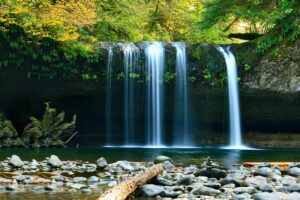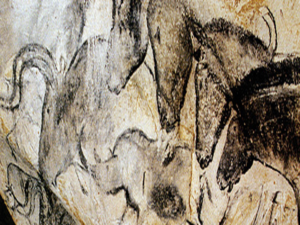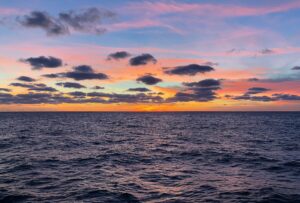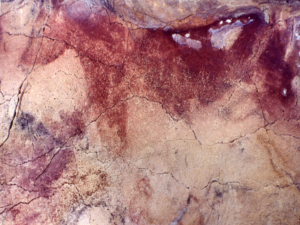INTRODUCTION
Thousands of years ago advanced seafaring people lived on land in the Pacific Ocean. Today their vanished civilization is known as Lemuria or Mu. Research of geology, archaeology, traditions, myths, legends and numerous other sources offers the opportunity to begin to understand this long lost people and their land.
THE LAND
Mu is the oldest name for the ancient Pacific civilization and it is usually used in esoteric literature. The word Lemuria has two sources. Scientists found lemurs, which are similar to monkeys with curled tails, in both Madagascar and New Guinea, two countries that are separated by water. But lemurs cannot swim. So the scientists decided Madagascar and New Guinea must have once been part of one land and they named it Lemuria after the lemurs. Prior to that, in old Roman times, “lemures” were ghosts or spirits. The Roman’s Festival of the Lemures goes way back to pagan practices – honoring the spirits of the dead, or perhaps trying to keep them away. In 45 of his readings Edgar Cayce referred to the lost land in the Pacific as either Lemuria or Mu.
Prior to 10,000 B.C. the topography of what is now a vast ocean area between the American continent and Asia was very different from what it is today. Substantial botanical and zoological evidence proves that extensive areas of habitable land were once above the surface of the Pacific Ocean. For instance, the tiny animals which produce coral cannot survive and grow in the warm water of the Pacific below 150 feet. However, coral is frequently found at greater depths in the Pacific Ocean, sometimes as much as 1800 feet below sea level, indicating that areas that are now deep under water were once in shallow water. The presence of coal and ancient flora on the tiny island of Rapa, one of the Austral Islands, provides proof that a land of considerable size was located in that region of the Pacific Ocean long ago.
Hawaiians told missionaries that there was once a continent that sank which extended from Hawaii to New Zealand, and all that remains of it are mountain tops in the form of islands. In support of the Hawaiian’s theory, numerous islands in the Pacific are peaks of mountains which originate on the sea floor as volcanoes. As he studied the legends of the aboriginal Pacific people, highly regarded British scholar Lewis Spence learned that myths and chronicles of a former land mass in the Pacific are just as numerous as the traditions of Atlantis, and just as striking, – classical and otherwise.
Opinions vary as to the exact location of Mu or Lemuria, but the most prevailing belief is that prior to 10,000 B.C. a mass of land approximately 3,000 miles wide stretched about 5,000 miles from Easter Island to Hawaii. Increasing evidence also indicates that at one time much of the southern Pacific was dry land, as well as some of the area between India and eastern Africa.
The floor of the Pacific is very unstable and occasionally the greedy ocean devours all that was once above the surface. In 1687 after a strong earthquake, the navigator of the Bachelor’s Delight accurately recorded the location of an island near Easter Island which was not on the charts. It was named Davis’ Land for John Davis, the captain of the ship. However, Davis Land has never been found. In 1836 heavily populated Tuanaki Island, which was south of the Cook Islands, suddenly disappeared with all but one of its inhabitants. This lucky man was visiting on a nearby island at the time of the surprising disaster.
In 1931, using the pen name Wishai S. Cerve, Harvey Spencer Lewis wrote the Rosicrucian publication entitled Lemuria:The Lost Continent of the Pacific. In addition, using this pen name, Lewis compiled Unto Thee I Grant.., also known as The Economy of Life, a collection of secret spiritual and ethical teachings of the Tibetans. He obtained the material in these works from a portfolio of very rare manuscripts a representative of the Rosicrucian brotherhood in China had carried to the Rosicrucian office in San Francisco. The information had been preserved for thousands of years in ancient archives of China and Tibet. It is reasonable to assume that the brotherhood in China, anticipating the coming suppression of information in that country and in Tibet, decided to make the sacred knowledge available to others. The priest took the valuable manuscripts to the Rosicrucian headquarters in California for safekeeping and publication. Lewis was selected to write these books because of his interest in archaeology, geology and meteorology. His intent was solely to present information from the very old manuscripts, not to prove it.
Cerve describes Lemuria as originally occupying most of the area which is now the Pacific Ocean. Gradually the very large continent disappeared and by 10,000 B.C. it was gone except for small islands. He reports that long ago, as tectonic plates moved, a remnant of submerged Lemuria pushed up against the western edge of the American continent, leaving a strip of land 300-500 miles wide from Vancouver, British Columbia to Baja California. He points out that as one nears the Pacific coast in western California, the composition of the soil changes. As a result, in this area giant redwoods flourish, as well as certain wild flowers and ferns that will not thrive in soil to the east.
From Cerve we learn that gently rolling hills and tumbling rivers characterized the countryside of early Mu. The vaporous steam rising from the abundant, bubbling hot springs, gave a surreal, misty impression to the landscape. Gradually, the environment changed as sections of our planet’s crust shifted and pushed against each other, forcing mountains up from the depths of the Earth. Lemuria became a more hilly country. The Ring of Fire, a chain of active volcanoes that surrounds a large section of the Pacific Ocean, demonstrates the presence of the frightening hot molten lava which was never far beneath the surface in Mu.
Cerve tells us that lush tropical vegetation of giant ferns and evergreens covered most of the country, making it a land of unsurpassed beauty. Sacred lotus flowers, one of the first flowers to appear on our planet, glistened like jewels along the shores of its shallow lakes. Coconut palms lined the rivers and fringed the ocean beaches. Just as plant life flourished in the warm climate, so insects grew to an enormous size. Fossilized specimens from islands in the Pacific reveal that in the tropical climate of Mu, roaches were four to five inches long, and two-inch ants with large wings were capable of flying long distances.
The five books of Colonel James Churchward (1851-1936) provide a large body of knowledge about Mu and it’s people. Churchward spent most of his life in southeastern Asia, Central America and the southwestern United States searching for information about Lemuria which he referred to as the lost Motherland of Mu. As he traveled he translated ancient writings on tablets and scrolls of clay, tree bark and palm leaves, and studied tribal traditions and legends, classical literature, engravings on statuary, and hidden information in temple archives.
Churchward learned that traditions say the lotus was the first flower to appear upon the earth and it became the symbolic flower of the Motherland of Mu. Migrating Lemurians carried their high regard for the lotus to Asia where it is still considered sacred. Lakshmi, the Ancient Hindu goddess of fortune & prosperity is often portrayed sitting on a lotus. Legend discloses that she was born full-grown and beautiful from the churning of the sea – the home of the Motherland of Mu. The lotus is also sacred to the Buddhists of India, Tibet, China and Mongolia.
THE PEOPLE
The main characteristic of the people of Mu was the high development of their inner mind. The whole society possessed a beautiful spiritual intensity very different from our materialistic culture. They could control their personal experience of time and learned to communicate telegraphically over great distances. They were able to reach levels of awareness and dimensions that only a few are beginning to comprehend today. With meditation and less focus on material objects we can expand our minds and acquire some of the skills of the Lemurians.
Cerve describes Lemurians as having what is called a third eye that slightly protruded from the center of their forehead. The third eye enabled them to perceive some of what escaped their other senses. As long as they used the valuable organ, it was available to enrich their lives, but when they gradually failed to take advantage of the third eye’s, its powers slowly declined and eventually almost disappeared. Many believe it was once connected with the pineal gland.
When they concentrated on using all their six senses, the people of Mu sensed something more. If they focused on a tree for instance, they saw its size and color, but they also recognized it as a living being with an intangible relationship to its environment, to nature, and to the cosmos. As a result of their extensive knowledge they were aware of a fourth dimensional world, and this spiritual aspect of life was of primary importance to them. Through meditation and their concentration on the spiritual they believed in reincarnation and that we’re all beams of light which will inevitably leave physical bodies. The knowledge that there was life after life was enhanced by their close contact with their ancestors who inhabited the other world.
When the people of Mu had accomplished what they thought was expected of them in this life, they were capable of leaving their bodies and making the transition to the spirit world. Churchward was convinced that the symbol of a skeleton with upraised arms and crossed legs is an emblem from Mu which they used in their religious ceremonies to further the impression that there is nothing to fear when the soul leaves the mortal body, for another life awaits.
Realizing their country would not survive forever, Lemurian priests traveled extensively to share their knowledge and insure it would be preserved. Colonists steadily moved from Mu to more stable surrounding lands, and eventually some descendants migrated as far as Egypt. The Tibetan spiritual tradition and the Hawaiian Huna tradition both have their roots in the Motherland of Mu. Wherever Lemurians went their symbols have survived to remind us of them. The skeleton with upraised arms and crossed legs is included in the liturgy of the Freemasons. The symbol is also found in Egypt, and is repeated many times on the cornices of the west temple in the Cemetery Group at Uxmal in the Yucatan.
Irish folklore offers the saying: “Knowledge, under the rule of the Golden Serpent, was mostly to be found in the West, while Wisdom, an entirely different thing, was to be found under the rule of the Golden Dragon, in the East.” Lemurians used their admirable wisdom to govern their widespread colonies with excellent results and they became world leaders in religion and philosophy.
Cerve reports that Lemurian scientists eventually succeeded in efficiently harnessing all of nature’s forces to meet every necessity and luxury they required. They cleverly constructed huge stone buildings that withstood earthquakes. The seaworthy ships of Lemuria sailed the ocean’s waters. Cerve describes their airships as being equipped not only with lights but also with very strong searchlights,
Lemuria is usually depicted as having had an ideal civilization – which was true for thousands of years.. However, some of the powerful priest-scientists developed an overwhelming interest in science and, as technology assumed a leading role in their lives it led to a focus on materialism. These leaders lost respect for what they could not perceive with their five senses and all that lies beyond the third dimensional environment. The spiritual quality of life became unimportant to them, they separated from their Creator, and their interest in scientific achievement slowly supplanted compassionate relationships. A class society evolved in which the priest-scientists were extremely powerful, not always to the benefit of humanity. Eventually Mother Earth rebelled.
Churchward discovered in Tibet a part of the Lhasa Record that offers this quotation about the disaster which destroyed Mu. “Seven cities with their golden gates and transparent temples quivered and shook like the leaves in a storm, and a flood of fire and smoke arose from the palaces. Agonies and cries of the multitude filled the air. They sought refuge in their temples and citadels and the wise Ra Mu arose and said to them: ‘Did I not predict all this?’ And the women and the men in their precious stones and shining garments lamented: ‘Mu, save us!’ and Mu replied: ‘You shall all die together with your servants and your riches, and from your ashes new nations will arise. If they forget they are superior not because of what they put on but because of what they put out the same will befall them. Flames and smoke choked the words of Ra Mu: the land and its inhabitants were torn to pieces and swallowed up by the depths.”
The catastrophe is further described in the following translations from two of the documents which survived the Spaniards’ devastating bonfires in Central America.
“Twice Mu jumped from her foundations. It was then sacrificed by fire. It burst while earthquakes violently shook it up and down. By kicking it, the wizard that makes all things move like a mass of worms, sacrificed it that very night.”
Codex Cortesianus“In the year six Kan, on the eleventh Mulue, in the month Zac, there occurred terrible earthquakes, which continued without intermission until the thirteenth Chuen. The country of the hills of mud, the ‘Land of Mu’, was sacrificed. Being twice upheaved, it suddenly disappeared during the night, the basin being continually shaken by volcanic forces. Being confined, these caused the land to sink and rise several times and in various places. At last the surface gave way, and the ten countries were torn asunder and scattered in fragments; unable to withstand the force of the seismic convulsions, they sank with sixty-four millions of inhabitants, eight thousand and sixty years before the writing of this book.”
Translated from the Troana manuscript
by Augustus Le Plongeon.
The waters of the vast Pacific now cover the beautiful country of Mu, but reminders of our ancestors who lived there so long ago are becoming increasingly obvious. Before 10,000 B.C. water from the oceans was incorporated in the snow and ice of the glaciers. As a result, sea levels were approximately 350 feet lower than today. Remains of substantial megalithic buildings which divers are discovering below the surface offer proof that when the Pacific Ocean was lower knowledgeable people spent time on land which has disappeared. Evidence manifests itself above the surface as well. The Lemurians went to North, Central and South America. Archaeologists have recently verified that people lived on the west coasts of these continents at least 11,000 years ago. As scientific research moves forward it insures that we will continue to learn more about the advanced seafaring individuals who lived in Lemuria so long ago.
BIBLIOGRAPHY
Brown, J. Macmillan, THE RIDDLE OF THE PACIFIC, Adventures Unlimited Press, Kempton, Illinois, 1996.
Cerve, W.W., LEMURIA, THE LOST CONTINENT OF THE PACIFIC, Supreme Grand Lodge of the Ancient & Mystiacal Order Rosae Crucis, San Jose California, 1931.
Churchward, James, THE LOST CONTINENT OF MU, William Edwin Rudge, New York, 1926.
Churchward, James, THE LOST CONTINENT OF MU, The C.W. Daniel Co. Ltd., Essex, England, and BE Books ℅ The Brotherhood of Life, Inc. Albuquerque, New Mexico, 1987.
Le Plongeon, Augustus, SACRED MYSTERIES, Macoy Publishing and Masonic Supply Co., New York 1909.
Spence, Lewis, ATLANTIS IN AMERICA, Sun Publishing Co., Santa Fe, New Mexico, 1981.
Spence, Lewis, THE PROBLEM OF LEMURIA, The Book Tree, San Diego, California, 2002. Originally published by Rider & Co., London, 1932.







